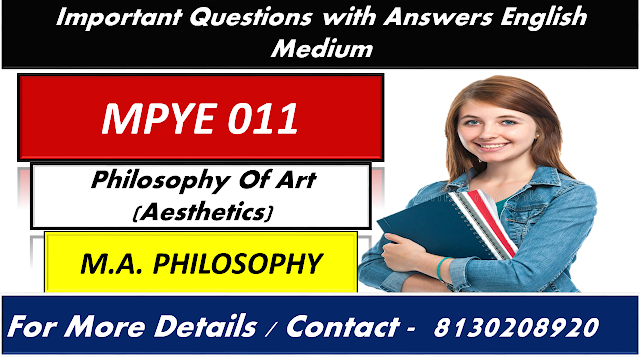IGNOU MPYE 011 Important Questions With Answers English Medium
MPYE 011 refers to the Master of Arts in Philosophy program's
course named "Philosophy of Arts (Aesthetics)" offered by the Indira
Gandhi National Open University (IGNOU) in India. It delves into the
philosophical exploration of art, aesthetics, and beauty.
Course
Structure:
Divided into four blocks, each exploring specific themes
within aesthetics.
- Block 1: Introduction to Aesthetics: Understanding the basics of aesthetic inquiry and different approaches.
- Block 2: Theories of Art: Examining prominent theories like formalism, expressionism, and cognitive theories.
- Block 3: Art and Perception: Exploring the connection between art and human perception, considering factors like emotion, imagination, and interpretation.
- Block 4: Art and Society: Analyzing the role of art in different contexts, including its social, cultural, and political functions.
Q.1
What is rasa according to Bharata ? Explain the determinants or vital elements of
rasa.
Rasa, as defined by Bharata Muni in his seminal work, the "Natya Shastra," is a fundamental concept in Indian aesthetics and dramaturgy. It refers to the emotional essence or flavor that an artistic performance evokes in the audience. The term is often translated as "aesthetic relish" or "sentiment," and it encapsulates the power of a creative work to elicit an emotional response.
IGNOU MPYE 011 Important Questions With Answers English Medium-Bharata Muni elucidates the theory of rasa in the context of dramatic arts, particularly in relation to classical Indian dance and theater. According to Bharata, there are eight primary rasas, each associated with a specific emotion or sentiment: Shringara (love), Hasya (laughter), Karuna (compassion), Raudra (anger), Veera (courage), Bhayanaka (fear), Bibhatsa (disgust), and Adbhuta (wonder).
To fully understand the concept of rasa, Bharata Muni introduces
the idea of the twenty determinants or vital elements (Vibhava, Anubhava, and
Vyabhichari Bhava) that contribute to the experience of rasa in a dramatic
performance. These elements work together to create a rich and nuanced
emotional tapestry, allowing the audience to connect with the artistic
expression on a profound level. Let's delve into each of the twenty
determinants and explore their significance in the manifestation of rasa.
IGNOU MPYE 011 Important Questions With Answers English Medium-The first category of determinants is Vibhava, which includes
Alambana (support), Uddipana (stimulus), and Anubhava (consequent). Alambana is
the foundation or support of the emotional experience, providing a context for
the rasas to unfold. Uddipana acts as a stimulus, triggering emotions within
the performer and subsequently the audience. Anubhava refers to the visible or
audible expressions of these emotions, such as facial expressions, gestures,
and vocal modulation.
Also Read-
- IGNOU MPYE 008 Important Questions With Answers English Medium
- IGNOU MPYE 010 Important Questions With Answers English Medium
- IGNOU MPYE 009 Important Questions With Answers English Medium
The second category is Anubhava, which encompasses Satvika
(involuntary reactions), Vyabhichari (transitory emotions), and Sattvika Bhava
(permanent emotions). Satvika represents the involuntary physical and emotional
reactions that naturally occur in response to stimuli, like sweating or
trembling. Vyabhichari Bhava refers to the transitory emotions that accompany
the primary emotion or rasa, amplifying its impact. Sattvika Bhava involves the
permanent emotional states that contribute to the overall mood, supporting the
dominant emotion.
The third category is Vyabhichari Bhava, which includes eight
transitory emotions that intensify the dominant rasa. These are Stambha
(stupor), Sveda (sweating), Romancha (horripilation), Ashru (tears), Vepathu
(trembling), Swarabheda (voice modulation), Pralaya (fainting), and Viveka
(discrimination). These elements add depth and complexity to the emotional
experience, ensuring a multi-dimensional engagement with the audience.
To illustrate these determinants in practice, consider the
rasa of Shringara (love). The Vibhavas could be the lovers, the romantic
setting, or the objects symbolizing love. The Anubhavas might include the
blushing of the lovers, the exchange of glances, and the tender gestures. The
Vyabhichari Bhavas could manifest as the trembling of the lovers, the tears of
joy, or the voice modulation expressing passion. Together, these determinants
create a harmonious and immersive experience of the Shringara rasa.
Bharata Muni's intricate framework of the twenty determinants
provides a comprehensive guide for artists to evoke and communicate emotions
effectively. It emphasizes the importance of a holistic approach to artistic
expression, where every element contributes to the overall aesthetic
experience. This approach aligns with the holistic worldview of classical
Indian philosophy, where the mind, body, and spirit are considered
interconnected aspects of human existence.
Q.2
Explain the concept of dhvani and examine its importance in aesthetics.
Q.3
Explain Hegelion theory of Aesthetics.
Q.4
Examine and compare the aesthetic theory of imitation according to Plato and
Aristotle.
Q.5
What is aesthetic experience ? Explain.
Q.6
Explain the various approaches to Aesthetics.
Q.7
How did Aquinas arrive that beauty belongs to the nature of formal cause ?
Q.8
Explain the application of aesthetics in any two fields of daily life.
Q.9
Explain the key concepts of Rasa theory in detail.
Q.10
Elucidate Beauty as meant by different thinkers.
Q.11
Discuss the views of postmodern thinkers on the theory of Aesthetics
Q.12
What are the categories of Rasas ? Illustrate.
Q.13
Explain the relation between Art and Epistemology.
Q.14
Elucidate the universality of the sense of beauty.
Q.15
Explain the application of Aesthetics in Information field.







0 comments:
Note: Only a member of this blog may post a comment.